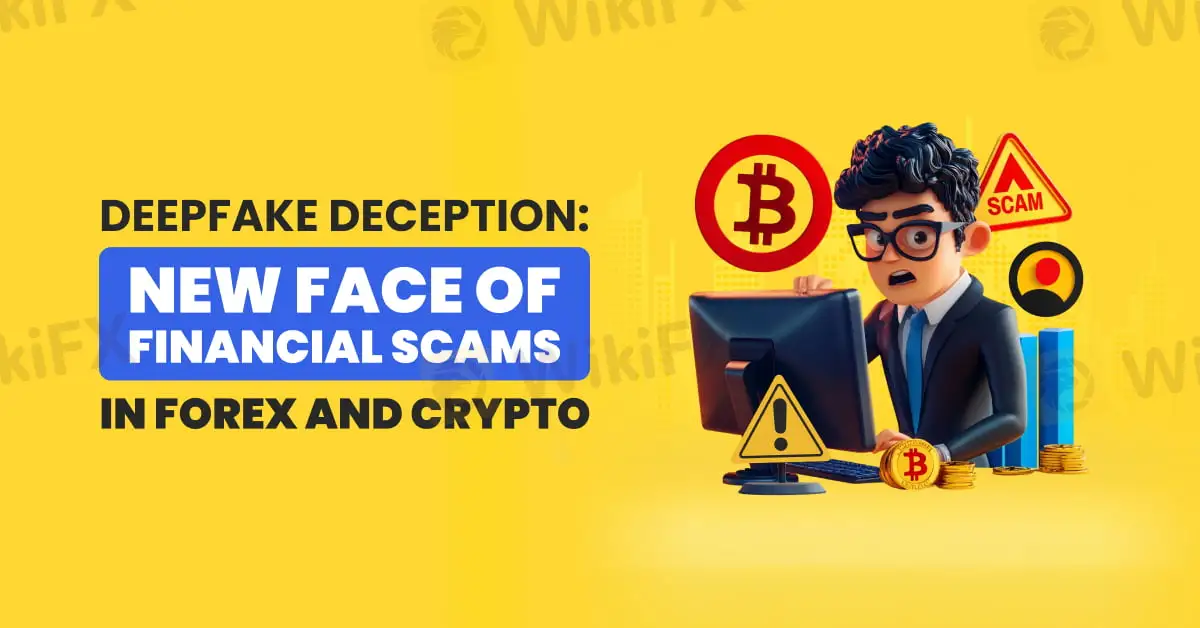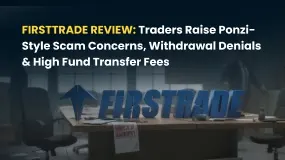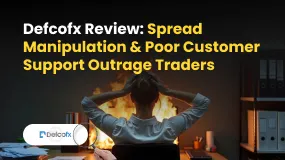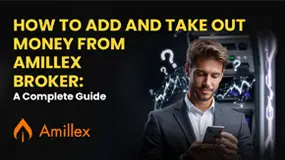简体中文
繁體中文
English
Pусский
日本語
ภาษาไทย
Tiếng Việt
Bahasa Indonesia
Español
हिन्दी
Filippiiniläinen
Français
Deutsch
Português
Türkçe
한국어
العربية
Deepfake Deception: New Face of Financial Scams in Forex and Crypto
Abstract:In the ever-evolving landscape of financial scams, fraudsters are now leveraging cutting-edge artificial intelligence (AI) to deceive unsuspecting victims. Deepfake technology, which manipulates audio and video to create hyper-realistic but entirely fabricated content, has become a powerful tool for scammers, particularly in the forex and cryptocurrency markets.

In the ever-evolving landscape of financial scams, fraudsters are now leveraging cutting-edge artificial intelligence (AI) to deceive unsuspecting victims. Deepfake technology, which manipulates audio and video to create hyper-realistic but entirely fabricated content, has become a powerful tool for scammers, particularly in the forex and cryptocurrency markets. These scams often involve impersonating well-known figures, creating fake endorsements, or even fabricating entire investment webinars to lure traders into fraudulent schemes.

Deepfake scams in the financial industry typically follow a well-crafted script. Scammers use AI-generated videos to impersonate reputable figures—such as CEOs of brokerage firms, famous traders, or financial analysts—to endorse fraudulent investment opportunities. These manipulated videos are often distributed through social media platforms, WhatsApp groups, or even directly via email campaigns.
One common tactic involves deepfake videos of financial influencers or industry leaders “promoting” a trading platform with promises of guaranteed high returns. Some fraudsters go as far as staging live video calls, where victims believe they are interacting with a real person, when in fact, it is an AI-generated deepfake controlled by the scammer. This level of deception adds a layer of credibility that traditional scams could never achieve, making it increasingly difficult for traders to differentiate reality from fiction.
Recognising deepfake scams requires vigilance and an understanding of the subtle inconsistencies that AI-generated content often exhibits. One of the most common red flags is unnatural facial movements. Deepfake videos may struggle to replicate natural eye movements, blinking patterns, or lip synchronisation when speaking. If something about the facial expressions or the way a person moves appears slightly off, it is worth investigating further.
The voice in a deepfake video can also provide clues. While AI-generated voices have improved significantly, they often lack natural intonations or may sound slightly robotic. In some cases, the tone may fluctuate awkwardly, or certain words may be pronounced in an unnatural way. Comparing the voice in a suspected deepfake with known recordings of the person can help reveal inconsistencies.
Another telltale sign is pixelation and blurring, especially around the edges of a persons face, which is common in AI-generated videos. These distortions become more apparent when the subject moves quickly or turns their head. If a video appears slightly off in quality, particularly in high-definition formats, it could indicate manipulation.
Deepfake scams often lure victims with offers that seem too good to be true. Any investment promising guaranteed profits with little to no risk should immediately raise red flags, regardless of how convincing the presenter appears. No legitimate financial institution can ensure risk-free returns, and any claim to the contrary is likely fraudulent.
Finally, verifying information from official sources is crucial. If a well-known figure is seemingly endorsing an investment opportunity, checking their official website or social media profiles can help confirm whether the endorsement is legitimate. Scammers frequently hijack the likeness of celebrities and financial experts without their knowledge, so relying on trusted sources for confirmation is essential.
To avoid falling victim to deepfake scams, always double-check identities before engaging with any financial offer. Conducting independent research on the company or individual making the claim can help uncover inconsistencies or past fraudulent activity. Official financial regulatory websites are useful sources for verifying whether a broker or investment platform is licensed.
It is also important to be wary of high-pressure tactics. Scammers often create a sense of urgency, urging victims to act quickly before an “exclusive opportunity” disappears. This strategy is designed to prevent critical thinking and force individuals into making impulsive decisions. Legitimate financial institutions do not rush investors into making commitments.
If a video or image seems suspicious, using reverse image and video search tools can help determine if it has been altered or used elsewhere. Scammers frequently recycle the same deepfake materials across multiple fraud schemes, so searching for prior instances of the same footage can expose the deception.
Strengthening online security is another crucial step. Enabling multi-factor authentication (MFA) on financial accounts adds an extra layer of protection against identity fraud. If scammers obtain personal details through deepfake scams, they may attempt to access victims' financial accounts, making additional security measures essential.
Before making any investment decision, consulting a licensed financial professional is always advisable. Relying on regulated experts rather than social media promotions or online videos ensures that investment choices are based on sound financial advice rather than fraudulent schemes.
As AI technology continues to advance, deepfake scams will only become more sophisticated. While governments and financial institutions are actively developing detection tools, awareness remains the strongest defence. By staying informed and scrutinising online financial offers carefully, traders can protect themselves from falling victim to these AI-driven frauds.
In an era where seeing is no longer believing, scepticism is no longer just an option—it is a necessity.

Disclaimer:
The views in this article only represent the author's personal views, and do not constitute investment advice on this platform. This platform does not guarantee the accuracy, completeness and timeliness of the information in the article, and will not be liable for any loss caused by the use of or reliance on the information in the article.
Read more

Firsttrade Review: Traders Raise Ponzi-Style Scam Concerns, Withdrawal Denials & More Issues
Have you lost all your capital while trading via Firsttrade? Does the US-based forex broker disallow you from withdrawing funds? Do you have to pay massive fees when transferring funds? Does your trade get affected because of frequent malfunction in the trading app? These have been haunting many traders at Firsttrade. Consequently, many of them have raised complaints online. In this Firsttrade review, we have shared such complaints. Keep reading to know about them.

Defcofx Review: Spread Manipulation & Poor Customer Support Outrage Traders
Does the poor customer support service leave you stunned when trading via Defcofx? Do you receive blunt, negative responses from the support team on several trading queries? Does the Saint Lucia-based forex broker pile on the losses for you by manipulating forex spread charges? In this Defcofx review, we have shared some complaints made against the broker. This will further answer your question: Is Defcofx real or fake?

How to Add and Take Out Money from Amillex Broker: A Complete Guide
Good money management is the foundation of successful trading. Learning how to make an Amillex Broker deposit and withdrawal is your first step toward trading with confidence. We know that for any trader, moving money must be safe, fast, and simple. This guide gives you a complete, step-by-step walkthrough for all amillex broker funding activities, so you can manage your account with total clarity. The whole process, from your first deposit to taking out profits, is made to be simple. You start by logging into your secure client area, picking a payment method that works for you, choosing the amount, and confirming the transaction. This guide will cover detailed deposit instructions, a full breakdown of withdrawal steps, a comparison of available payment methods, and a detailed look at the security measures protecting every transaction.

FCA warning: These Firms are on the list
In 2025, the UK’s Financial Conduct Authority (FCA) intensified its crackdown on financial misconduct, issuing a series of fines and public warnings against both major institutions and forex brokers. This article provides an updated list of brokers, banks, and financial platforms that have been recently fined, banned, or listed on the FCA’s warning list, highlighting the importance of transparency and investor protection in the UK’s financial market.
WikiFX Broker
Latest News
INTERPOL, AFRIPOL Crack Down on Africa Terror Finance
Forex Scam Checker Philippines: Verify Brokers with WikiFX
MH Markets Review 2025: Trading Platforms, Pros and Cons
Mekness Review: Traders Report Alleged Fund Scams & Account Blocks
Octa FX in Pakistan: The Complete Guide to Local Payments, Regulation, and Support
D Prime to Exit Limassol Office Amid Doo Group Restructure
WikiFX Elites Club Committee Concludes Voting! Inaugural Lineup Officially Announced
Fake Trading Platforms Are Spreading Fast Across Asia | How Investors Are Being Tricked
eToro CopyTrader Expands to U.S. Investors
Is MH Markets Safe or a Scam? Regulation and Fund Security Explained
Currency Calculator



